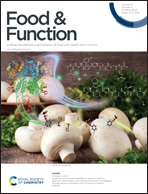Cell culture models for assessing the effects of bioactive compounds in common buckwheat (Fagopyrum esculentum): a systematic review
Abstract
Common buckwheat (CBW) is grown and consumed worldwide. In addition to its already established reputation as an excellent source of nutrients, CBW is gaining popularity as a possible component of functional foods. Whereas human studies remain the gold standard for evaluating the relationship between nutrition and health, the development of reliable in vitro or ex vivo models has made it possible to investigate the cellular and molecular mechanisms of CBW effects on human health. Herein is a systematic review of studies on the biological effect of CBW supplementation, as assessed on various types of cellular models. Although the studies reported here have been conducted in very different experimental conditions, the overall effects of CBW supplementation were found to involve a decrease in cytokine secretion and oxidation products, related mainly to CBW polyphenols and protein or peptide fractions. These chemical species also appeared to be involved in the modulation of cell signaling and hormone secretion. Although further studies are undoubtedly necessary, as is their extension to in vivo systems, these reports suggest that CBW-based foods could be relevant to maintaining and/or improving human health and the quality of life.

- This article is part of the themed collection: Food & Function Review Articles 2024


 Please wait while we load your content...
Please wait while we load your content...